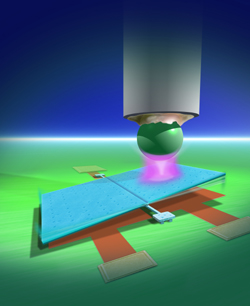Casimir Force Holds Empty Promise

Physicists have spent centuries tailoring materials to meet their needs, but a new experiment attempts to engineer with empty space. Researchers placed a tiny sphere within nanometers of an oscillating plate. A minuscule quantum mechanical attraction between the sphere and plate lowered the frequency of the plate’s vibration, and the team varied the frequency by moving the bead. The experiment was the first measurement of the effects of the so-called Casimir force on a mechanical system. The results, appearing in the 19 November print issue of PRL, may lead to microscopic machines that use the force of empty space as one of their components.
At the heart of these experiments is the Casimir effect, a phenomenon from quantum electrodynamics (QED). QED dictates that all space, even empty space, is filled with an infinite number of electromagnetic vibrations. When two uncharged metal surfaces are brought within nanometers of each other, there’s a limit on the number of vibrations that can exist between them. The vibrations outside the plates create an inward pressure that pushes the plates together–the Casimir force.
Federico Capasso and his team at Bell Labs in Murray Hill, NJ, used the Casimir force to control a tiny mechanical oscillator. They applied an alternating (AC) electric field to an uncharged metallic paddle, which caused it to seesaw at a fixed frequency and amplitude. Using a fine-tipped probe, they then lowered a gold plated sphere 100 µm in diameter toward the surface of the paddle. As the sphere came to within a few hundred nanometers of the surface, the team detected a change in the natural frequency of the paddle. By adjusting the height of the sphere by a few nanometers, they could alter the amplitude and frequency of oscillations.
“The importance of this work is clearly in engineering applications,” says Umar Mohideen of Columbia University in New York City. The Casimir force could cause micromechanical components to stick together, he explains, and so it is important to understand how it interacts with moving parts like the oscillator. Capasso believes that engineers could use their understanding of the Casimir force to design micromachines where empty space is used as a component. For example, he says, a version of this oscillator could be used as a precise position sensor. “In my opinion,” he says, “there are lots of opportunities to engineer these quantum electrodynamic forces.”
–Geoff Brumfiel


